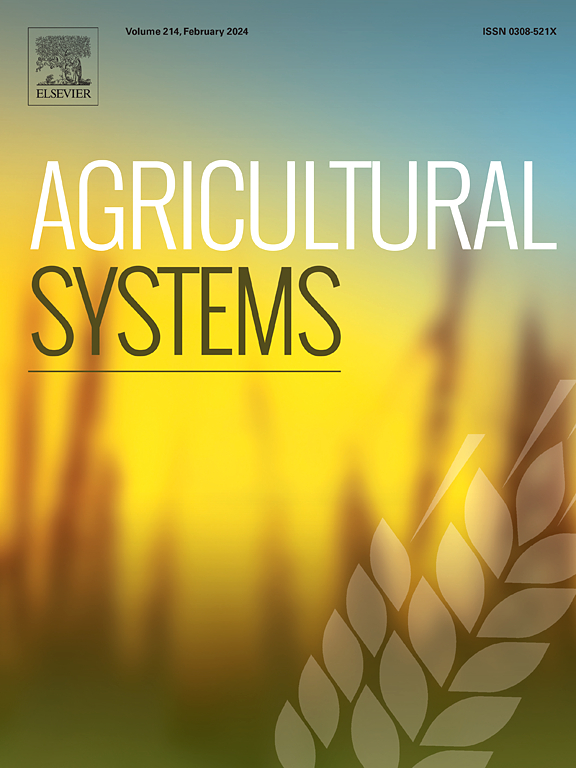法国谷物种植区与沼气植物相关的耕作制度变化
IF 6.1
1区 农林科学
Q1 AGRICULTURE, MULTIDISCIPLINARY
引用次数: 0
摘要
好氧消化(AD)是一种产生可再生气体(沼气)和有机肥料(消化液)的过程。在两种主要作物之间种植的能源覆盖作物预计将成为法国和其他欧洲国家的主要农业原料,有可能改变种植制度和农业做法。然而,与AD相关的农业系统仍未得到充分研究,这可能导致AD评估与实际农业实践脱节。我们的目的是通过描述法国农场与主要依赖谷物种植区能源覆盖作物的沼气植物相关的种植制度变化特征来解决这一差距,并讨论与AD评估中通常考虑的农业实践的差异。方法:我们在2020年底至2023年期间对法国谷物种植区的33个农场进行了访谈,以表征与AD相关的非畜牧业农场种植制度的变化。访谈指南涵盖了一般农场和沼气植物信息,主要作物和能源覆盖作物管理,农场规模施肥和消化管理。考虑了AD前后的土地覆盖变化,并计算了简化的农场尺度养分(N、P、K)平衡。结果与结论主要发现表明,能源覆盖作物平均每年种植在农场表面的30%。它们一般都是用杀虫剂处理的,在被调查的农场中,有一半在夏季种植时进行灌溉。它们的引入意味着生长期较长的作物(如小麦和油菜籽)的表面显著减少,而大麦、玉米和其他谷类作物的表面增加。39%的答复者报告说,冬季能源覆盖作物之后,主要作物的产量损失为- 10%至- 40%,主要原因是夏季作物的播种日期推迟,导致生长期缩短。通过沼气池施用可实现的潜在肥料节约因农场而异,并与沼气池中农工副产品的比例呈正相关。意义本研究首次描述了谷物种植区以能源覆盖作物为主的非畜牧业AD农场的农业实践。它突出了观察到的做法与AD评估中考虑的做法之间的差异。未来对AD的地方或国家评估应该考虑到实际的农业实践,评估气候变化和潜在的水资源短缺对AD种植系统的影响。这对于减轻能源转换带来的任何不利影响是必要的。本文章由计算机程序翻译,如有差异,请以英文原文为准。

Changes in cropping systems associated with biogas plants in French cereal-growing areas
CONTEXT
Anaerobic digestion (AD) is a process that produces a renewable gas (biogas) and an organic fertilizer (digestate). Energy cover crops, grown between two main crops, are expected to become the predominant AD feedstock in France and other European countries, potentially reshaping cropping systems and agricultural practices. However, farming systems linked to AD remain understudied, potentially leading to AD assessments disconnected from actual farming practices.
OBJECTIVE
Our aim was to address this gap by characterizing the cropping system changes in French farms associated with biogas plants mainly relying on energy cover crops in cereal-growing regions and to discuss the differences with agricultural practices usually considered in AD assessments.
METHODS
We conducted interviews on 33 farms in French cereal-growing regions between late 2020 and 2023 to characterize changes in cropping systems of non-livestock farms associated with AD. The interview guide covered general farm and biogas plant information, main crop and energy cover crop management, farm-scale fertilization and digestate management. Land cover changes before and after AD were considered, as well as the calculation of a simplified farm-scale nutrient (N, P and K) balance.
RESULTS AND CONCLUSIONS
Key findings revealed that energy cover crops were grown on an average of 30 % of farm surfaces each year. They were generally treated with pesticides, and irrigated on half of the surveyed farms when cultivated in summer. Their introduction implied significant reductions in surfaces of crops with longer growing periods, such as wheat and rapeseed, while the surface of barley, maize and other cereal crops increased. Yield losses of −10 % to −40 % in main crops following winter energy cover crops were reported by 39 % of respondents, who mainly attributed them to delayed sowing dates of summer crops, resulting in a shorter growth period. Potential fertilizer savings achievable through digestate application varied across farms and were positively correlated with the proportion of agro-industrial byproducts in the digester.
SIGNIFICANCE
This study provides the first description of agricultural practices of non-livestock farms with AD based mainly on energy cover crops in cereal-growing regions. It highlights discrepancies between observed practices and those considered in AD assessments. Future local or national assessments of AD should account for actual on-farm practices, evaluating the impacts of climate change and the potential water scarcity on cropping systems with AD. This is necessary to mitigate any adverse effects resulting from the energy transition.
求助全文
通过发布文献求助,成功后即可免费获取论文全文。
去求助
来源期刊

Agricultural Systems
农林科学-农业综合
CiteScore
13.30
自引率
7.60%
发文量
174
审稿时长
30 days
期刊介绍:
Agricultural Systems is an international journal that deals with interactions - among the components of agricultural systems, among hierarchical levels of agricultural systems, between agricultural and other land use systems, and between agricultural systems and their natural, social and economic environments.
The scope includes the development and application of systems analysis methodologies in the following areas:
Systems approaches in the sustainable intensification of agriculture; pathways for sustainable intensification; crop-livestock integration; farm-level resource allocation; quantification of benefits and trade-offs at farm to landscape levels; integrative, participatory and dynamic modelling approaches for qualitative and quantitative assessments of agricultural systems and decision making;
The interactions between agricultural and non-agricultural landscapes; the multiple services of agricultural systems; food security and the environment;
Global change and adaptation science; transformational adaptations as driven by changes in climate, policy, values and attitudes influencing the design of farming systems;
Development and application of farming systems design tools and methods for impact, scenario and case study analysis; managing the complexities of dynamic agricultural systems; innovation systems and multi stakeholder arrangements that support or promote change and (or) inform policy decisions.
 求助内容:
求助内容: 应助结果提醒方式:
应助结果提醒方式:


